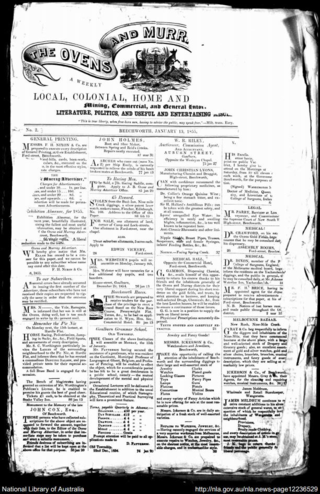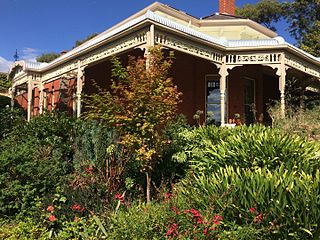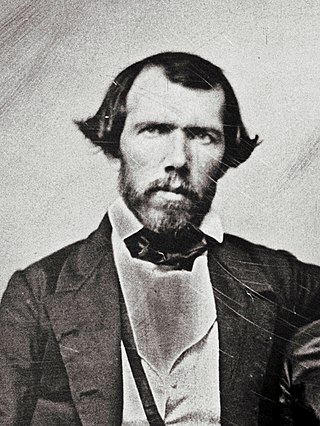
The Eureka Rebellion was a series of events involving gold miners who revolted against the British administration of the colony of Victoria, Australia during the Victorian gold rush. It culminated in the Battle of the Eureka Stockade, which took place on 3 December 1854 at Ballarat between the rebels and the colonial forces of Australia. The fighting left at least 27 dead and many injured, most of the casualties being rebels. There was a preceding period beginning in 1851 of peaceful demonstrations and civil disobedience on the Victorian goldfields. The miners, many of whom such as Raffaello Carboni came from Europe and were veterans of the Revolutions of 1848, had various grievances, chiefly the cost of mining permits and the officious way the system was enforced.

The Eureka Flag was flown at the Battle of the Eureka Stockade, which took place on 3 December 1854 at Ballarat in Victoria, Australia. It was the culmination of the 1851–1854 Eureka Rebellion on the Victorian goldfields. Gold miners protested the cost of mining permits, the officious way the colonial authorities enforced the system, and other grievances. An estimated crowd of over 10,000 demonstrators swore allegiance to the flag as a symbol of defiance at Bakery Hill on 29 November 1854. It was then flown over the Eureka Stockade during the battle that resulted in at least 27 deaths. Around 120 miners were arrested, and many others were badly wounded.

Peter Fintan Lalor was an Irish-Australian rebel and, later, politician who rose to fame for his leading role in the Eureka Rebellion, an event identified with the "birth of democracy" in Australia.

The Argus was an Australian daily morning newspaper in Melbourne from 2 June 1846 to 19 January 1957, and was considered to be the general Australian newspaper of record for this period. Widely known as a conservative newspaper for most of its history, it adopted a left-leaning approach from 1949. The Argus's main competitor was David Syme's more liberal-minded newspaper, The Age.

John Basson Humffray was a leading advocate in the movement of miner reform process in the British colony of Victoria, and later a member of parliament.

Henry Erle Seekamp was a journalist, owner and editor of the Ballarat Times during the 1854 Eureka Rebellion in Victoria, Australia. The newspaper was fiercely pro-miner, and he was responsible for a series of articles and several editorials that supported the Ballarat Reform League while condemning the government and police harassment of the diggers. After the Rebellion was put down, he was charged, found guilty of seditious libel, and imprisoned, becoming the only participant to receive gaol time.

Ballarat East is a suburb of Ballarat in Victoria, Australia. From 1857 until 1921 the suburb had its own council. The suburb covers a large area east of the city centre. It is the oldest urban area in Ballarat and was the site of many goldmines, as well as of the Eureka Rebellion.

The Bendigo Advertiser is an Australian regional newspaper. It is the daily (Monday–Saturday) newspaper for Bendigo, Victoria, and its surrounding region. The paper is published by Australian Community Media with a circulation between 5,000 and 7,000 depending on the day of publication.

The City of Ballaarat was a local government area covering the inner suburbs of the regional city of Ballarat, Victoria, Australia. The city covered an area of 34.52 square kilometres (13.3 sq mi), and existed from 1855 until 1994.
The Ballarat Courier is a newspaper circulating in the Ballarat region of regional Victoria. It is published daily from Monday to Saturday.

Henry Sutton was an Australian designer, engineer, and inventor credited with contributions to early developments in electricity, aviation, wireless communication, photography and telephony.

William Bramwell Withers was a journalist and novelist best known for writing the first history of Ballarat, Victoria. Born in England, Withers moved to the Colony of Natal in 1849 and contributed to local newspapers. He moved to Victoria in 1852, working odd jobs before becoming a reporter for the Argus and the Herald in Melbourne.

The Battle of the Eureka Stockade was fought in Ballarat, Victoria, on 3 December 1854, between gold miners and the colonial forces of Australia. It was the culmination of the 1851–1854 Eureka Rebellion during the Victorian gold rush. The fighting resulted in at least 27 deaths and many injuries, the majority of casualties being rebels. The miners had various grievances, chiefly the cost of mining permits and the officious way the system was enforced.

Ovens and Murray Advertiser, also published as The Chiltern andHowlong times, Ovens register, and Beechworth and district news, is a weekly English language newspaper published in the town of Beechworth, Victoria, Australia.

The Ararat Advertiser is a newspaper published in Ararat, Victoria, Australia. It is one of the oldest continuously operating newspapers in Victoria, second in age only to the Geelong Advertiser. The paper is now published by Fairfax Media.
Alfred Angel Black was an Australian cricketer. He played two first-class cricket matches for Victoria in 1858. He was "Minister of War" of the insurgents in the Eureka Stockade.

Trelawny is a gracious heritage house located at 804 Havelock Street, Black Hill, a suburb of the Victorian gold rush city of Ballarat, Victoria, Australia. Havelock Street, the street where Trelawny is located, was named in recognition of Major General Sir Henry Havelock, a British general who is particularly associated with India and the Indian Mutiny of 1857.

William Beauclerc Otway was a mid-nineteenth-century American dragoon, overland emigrant, merchant, mineralogist, gold-miner and quartz-crusher. He is credited with being the first person to crush quartz for gold at Ballarat and for an early attempt to mine and process silver ore at St Arnaud.
The following bibliography includes notable sources concerning the Eureka Rebellion. This article is currently being expanded and revised.

The Eureka Stockade Memorial Park is believed to encompass the site of the Battle of the Eureka Stockade that was fought in Ballarat on 3 December 1854. Records of "Eureka Day" ceremonies at the site of the battle go back to 1855. In addition to the Eureka Stockade Monument, there are other points of interest in the reserve, including the Eureka Stockade Gardens and an interpretative centre. There was formerly a swimming pool and other structures. There has been a nearby caravan park since the 1950s. The present Eureka Stockade Memorial Park Committee has undergone several name changes since 1922.



















